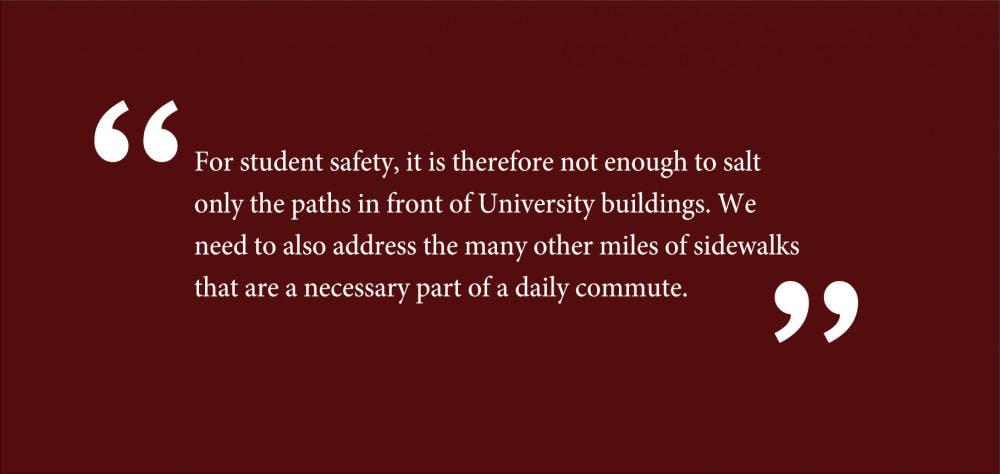On the first day of classes, I walked to campus up to College Hill on sidewalks that had seen little shoveling or salting. On many occasions it seemed safer to walk on the plowed and salted streets, which put me in danger of automobile traffic but limited my chances of slipping and falling. On sidewalks that are already hazardous from breaks and obstructions, pedestrian commuting can be made significantly more dangerous by winter weather.
The University and the City of Providence should do more to ensure that sidewalks are navigable and accessible, especially in the winter. Ice-lined sidewalks are unsafe to walk on and may prevent students from making it to class. Uncleared ramps and incomplete shoveling may also prevent access.
Even without winter weather, parts of our sidewalks can still be dangerous. Many of the brick-paved sidewalks in Providence prove slippery not just in icy conditions, but in rain or even when covered with fallen leaves. Uneven sidewalks, broken by tree roots or just wear and tear, create impassable conditions for many students. Additionally, much of Providence has stone curbs, rather than concrete curbs, which are particularly dangerous, as they are both slippery and nearly indistinguishable from their concrete counterparts. While broken sidewalks are outside the purview of the University, they add to the difficulties of winter commuting. In addition to increasing winter maintenance, the University should work with the City to improve sidewalks themselves.
University Facilities clearly has a lot of work to do in the winter, which should be acknowledged. But sidewalk accessibility continues to impact students. There must be ways to ensure that sidewalks are safe and accessible to all students, especially in the winter. And the winter weather is not letting up, either. With record-breaking cold snaps in the Midwest, it’s clear that dangerous winter weather must be confronted head-on. It is critical that the University and the City of Providence take timely action to ensure safe sidewalks.
In order to be truly accessible to all members of the Brown community, the areas of sidewalks at street crossings need to be shoveled and salted all the way to the curb and down the curb ramp. Additionally, clearing this area allows pedestrians to see potential hazards, as accumulated snow and ice may hide slippery stone curbs or a significant drop to street level.
One critical issue that the University, and the City of Providence to an extent, must recognize is that a large number of students often travel on off-campus sidewalks. With high rent prices on College Hill, students, particularly graduate students, are often forced to live far away from campus. For student safety, it is therefore not enough to salt only the paths in front of University buildings. We also need to address the many other miles of sidewalks that are a necessary part of a daily commute.
Further, while Providence requires homeowners to manage the sidewalk in front of their properties, members of the University should be more understanding of how off-campus sidewalk conditions impact student commutes. For instance, professors and administrators should expect students to be late or possibly absent. In the long term, the University should consider working with the city to improve winter sidewalk accessibility.
Sidewalks should be renovated to remove crumbling, rolling brick hills that are difficult to shovel and even more difficult — potentially impossible — to navigate. According to the campus accessibility map, many paths are inaccessible due to slope or obstructions, and no amount of proper winter care can fix this. The City of Providence is responsible for sidewalk renovations, so it may be necessary for the University to work with the City to bring about necessary structural changes. Since little progress has been made in repairing sidewalks since the Providence City Council passed a resolution to address the matter in 2014, perhaps partnering with the University could produce positive changes.
Additional difficulties include regulations surrounding registered historic locations and landmarks as well as a persistent lack of funds. Despite these challenges, the University and City must take steps to ensure sidewalk accessibility for students. In the meantime, the University should prioritize all small steps that improve winter accessibility.
E.L. Meszaros GS can be reached at e.l.meszaros@brown.edu. Please send responses to this opinion to letters@browndailyherald.com and op-eds to opinions@browndailyherald.com.





